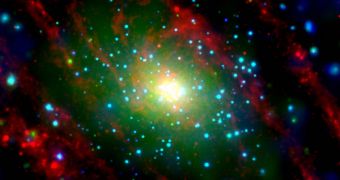Using radiation emitted by a maser in the Andromeda galaxy, astronomers are now analyzing the path our neighboring galaxy is taking, in an effort to determine whether and when it will collide with the Milky Way. The new study may help improve current estimates.
At this point, scientists believe that it will take about 5 billion years for the two galaxies to merge at their current speeds. However, it could be that Andromeda is not heading necessarily straight for us.
It could be moving laterally as well, and studying light emitted by a laser-like cosmic body within it may finally reveal whether that is truly the case. The work is conducted by astronomer Loránt Sjouwerman, who is based at the National Radio Astronomy Observatory in Socorro, New Mexico.
He and his team say that a maser can be broadly defined as a bright, laser-like spot of microwave radiation, originating from a single point Andromeda. Studying its characteristics over time may provide us with the information we need for assessing the galaxy's motion patterns.
Generally, astronomers use an effect called the Doppler shift of light to determine how fast galaxies are traveling towards us, or away from us. But Andromeda is simply too close to allow for this technique to reveal information on the small-scale variations of the galaxy's sideway motions.
Interestingly, if Andromeda moves sideways fast enough, it may not collide with the Milky Way after all. The two galaxies would still influence each other considerably, through gravitational and tidal forces, but they would not merge and become a single, supermassive galaxy.
“Measuring the proper motion of Andromeda is key to determining the fate of the Milky Way. Such a measurement is best done with a compact, bright source such as a maser, but until now no maser strong enough for current telescopes to measure has been detected,” says astronomer Mark Reid.
The expert, a member of the research team, holds an appointment at the Harvard-Smithsonian Center for Astrophysics (CfA) in Cambridge, Massachusetts. The methanol maser in Andromeda was imaged using the newly-improved Very Large Array (VLA), in New Mexico.
If Andromeda and the Milky Way collide, their black holes would merge too, forming a tremendously large monster at the core of a new, elliptical galaxy. The merger would be accompanied by an intense bout of stellar formation, Daily Galaxy reports.

 14 DAY TRIAL //
14 DAY TRIAL //